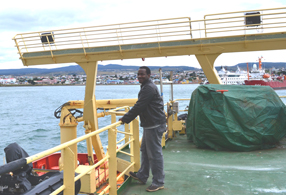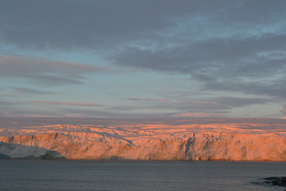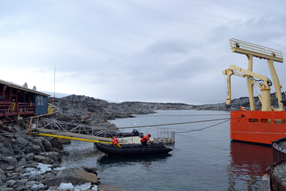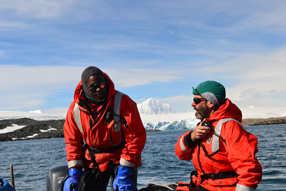
In Punta Arenas, Chile on Tuesday February 12th, the members of UAB 2013 Antarctic field team awaited departure to our final destination: Palmer Station, Antarctica. The ship taking us was the 250 foot long, ASRV (Antarctic Survey and Resupply Vessel) Laurence M. Gould, designed to traverse the cold southern ocean and Antarctic ice. We walked around the ship’s deck taking pictures of our surroundings. The other members of the team reminisced about field seasons prior and their wonderful experiences. I looked around at their faces and was filled with an eager anticipation of things to come.
With all preparations for departure complete, the crew of the L.M. Gould cast off lines from the dock. I quickly grabbed my new camera from the berthing area and came back to the deck. I found Chuck, Maggie, Julie, and Kate all waiting to see the last lines cast from the ship. As the lines were collected and our last ties to land cut, the men and women working on the ship and at port waved and yelled goodbye. The ship drifted away from land. I had a realization that this is it; this was my last view of the Americas until my return from Antarctica.
The trip from Punta Arenas to Palmer Station is usually four to five days. The L.M. Gould moved further and further from South America. The size of the ocean and isolation of our destination became more and more obvious. The smell of the salt air filled my lungs. The sights and sounds of the open ocean started to fill consciousness, particularly the incessant movement of the ocean beneath the ship. Chuck and Maggie told me I was experiencing a particularly calm crossing so far. However, the more difficult leg of the voyage was yet to come, the Drake Passage. The Drake one of the more volatile and difficult transects of the world’s oceans. The Drake, as it’s referred to, drops off of to a depth of more than five thousand meters at points and is notoriously turbulent.
Chuck told me a story of someone being tossed from their bunk asleep, and awaking midair, before hitting the floor. I made sure to wedge myself in while sleeping to avoid this rude awakening. After a day in the Drake, I found myself surround by water as far as my eyes could see. The sea was no longer as calm as at the onset of our voyage. However, with the absence of land, the curvature of the horizon became one with the sky.
Sea birds floated on the water nearby. Whales breached the surface of the water. The sun started to set later and later into the evening. Eventually, the temperature began to drop. Snow fell and dusted the L.M. Gould as we continued our trek.
Everyday Chuck, Maggie, Julie, Kate, and I would walk around on the deck and stretch our legs, taking sight of the horizon ahead of us. I stood at the precipice of the ship watching the raw power of the ocean clashing with the ice breaker. This voyage illustrated how miniscule men and all we build are. In the deepest part of the Drake, the ship rocked and swayed to and fro, confirming the Drake’s reputation for brutality.

Early Saturday morning, we reached the South Shetland Islands. These islands are one of the more beautiful sites in the southern oceans. Throughout the day, the L.M. Gould by nature’s frozen monuments. Icy bodies littered the waterways, including gigantic icebergs the size of buildings or even city blocks. Large boulder and bowling ball sized bodies of ice amassed as well stretched hundreds of meters. It seems like a great artist crafts millions of glass sculptures, shaping them with time, wind, and water from the sky and sea, painting them clear, translucent, white, and every shade of blue. They seem to dance and spin in the water, or they stand stoically waiting for a witness to their splendor or the elements to whittle them away.

The crew of the L.M. Gould and the staff at Palmer waved and yelled salutations. They began to tether the ship to the dock. The station sat on a small strip of stone and rocks beneath an expansive glacier, which Dr. McClintock often spoke of vividly at UAB. You will be introduced to the station in another entry. (There's too much new for me to explain.) But I want to say now that Dr. McClintock explained how the glacier was a shadow of its past. In seeing the glacier with my eyes, spanning the breadth of my vision, I could fathom something to cast a shadow so grand.
Once at Palmer, I began boating training to utilize the Zodiac. The Zodiac is an inflatable vessel used for transport from Palmer to and from surrounding areas. Training is essential due to the threat of hyperthermia from exposure and the water, as well as transport hazards such as ice. Besides the operation of the vessel, the boating training taught me to identify caches of supplies in case we were somehow stranded. These caches contain everything one would need to survive including shelter, food, water, and a heat source.

Chuck also is training me to safely pick up and drop off the divers, as well as manage the diver alert system. This system allows me to alert the divers to dangers such as leopard seals or the ephemeral weather here in Antarctica. I am becoming proficient at maneuvering the Zodiac, as well as assessing dangers to the vessel and the divers. The Antarctic is a beautiful place, but everyone’s job and priority is safety.